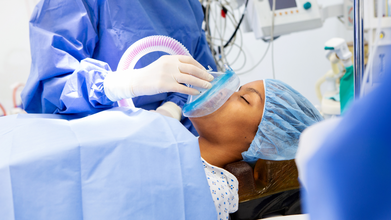- Health Conditions A-Z
- Health & Wellness
- Nutrition
- Fitness
- Health News
- Ayurveda
- Videos
- Medicine A-Z
- Parenting
- Web Stories
Why Do We Always Catch A Cold In Winter?

Image Credit: Canva
Every winter, I’d blame the chilly air and my sinus infection for my frequent colds, but it was actually the cold months which weaken nasal defenses, dry the air, and increase indoor gatherings, making viruses thrive. Now, with better habits and prevention, its easier to manage my symptoms through the frosty seasons.
Perhaps you have heard someone advise you to wrap up during winter to not catch a cold. You would have thought that this saying was entirely baseless because science, indeed, proved that, yes, it's true. Respiratory infections, the common cold among them, are more widespread in winter months. However, this does not mean that it is caused by cold weather. What happens is that it develops conditions that cause higher susceptibility to infections.
In the United States, flu season typically lasts from October till April. According to the estimation of the Centers for Disease Control and Prevention (CDC), in the 2022–2023 flu season, there were approximately 26–50 million influenza cases. But why are people falling sick during winter? Read to understand the reasons:
Why Do We Get Sick in Winter?
Closer Quarters and Poor Ventilation
The simplest explanation arises from human behavior during colder months. As the temperature cools down, we tend to get inside, where we are often much closer to other individuals. Places such as schools, offices, malls, and theaters have poor circulation systems, which provide an easy target for viruses. Common viruses that cause cold and flu spread through droplets that erupt into the air when infected person sneezes or coughs or even talking. These droplets suspended in the air or settle upon highly touched surfaces, which contribute to the spread.
Viruses Thrive in Dry Air
Cold-season air is drier outside as well as inside. Many people use heating systems during winter, which dries out the air in buildings. Researchers have shown that flu and other respiratory viruses remain more stable and transmit more readily in low humidity environments. In addition, dry air reduces resistance in the human body. For example, epithelial cells in our nostrils-the first line of defense against germs-are not so good at flushing out the viruses under such conditions. Cilia-very tiny hair-like structures in the respiratory tract-will also fail to wiggle and throw off germs when the air is too dry.
Cold Weather Weakens Immune Respons
Recently it has emerged that exposure to cold may weaken the immunity of an individual. The key part which filters germs in an individual is his nose. When exposed to cold air, the nasal cells produce less virus-fighting extracellular vesicles; these are tiny sacs trapping viral particles before they can infect the person. This decreased immunity through the nose exposes an individual to infections more.
Humidity Matters
A groundbreaking study in 2019 demonstrated the role of humidity in immune function. Scientists found that mice exposed to dry air conditions (10–20% relative humidity) could not fight flu infections as effectively as those mice in moderate humidity (50%). The study showed that dry conditions affect the movement of cilia and the secretion of interferons, which are chemicals that prevent viral replication. Although this study was conducted on mice, similar effects have been seen in humans.
Peak Seasonal Pattern
Winter coincides with the peak activity of most respiratory viruses, such as the flu, RSV, and even COVID-19. Researchers think that these viruses have evolved to flourish in the cold, dry climate of winter, hence increasing the possibility of transmitting the disease.
How to Prevent Winter Illness
While one can't eliminate the possibility of falling sick completely, you can be prepared for winter illness in the following ways:
1. Maintain Hygiene
Key is proper hygiene practices such as hand washing, covering your mouth when coughing or sneezing, and proper disinfection of surfaces that decrease the spread of viruses.
2. Keep Yourself Healthy
A healthy lifestyle does go a long way in building up your immune system. Stay hydrated, take a balanced diet full of fruits and vegetables, and keep yourself sleeping well and get active through exercises.
3. Stay Home When Sick
Isolation when ill prevents you from spreading germs to others. If you have a cold or flu, keep resting and recovering at home.
4. Maintain Moist Indoor Air
A humidifier can help maintain optimal humidity levels in your home—around 40–50%—keeping nasal passages and other respiratory defenses in top condition.
5. Get Vaccinated
Flu vaccines and COVID-19 boosters are important measures to prevent the severity of disease. The CDC advises that everyone six months and older should get vaccinated, as immunity starts about two weeks after vaccination.
6. Mask Up
Wearing a mask can decrease the transmission of respiratory viruses, especially in crowded indoor environments.
Beyond winter, it's essential to have regular check-ups with your primary care provider to maintain overall health. Together, you can work on a wellness plan that is tailored to your needs, making you better prepared to face flu season and beyond.
Winter itself does not make you sick, but it sets the stage for conditions that do. And by understanding the interplay of cold air, low humidity, and indoor crowding, you can take steps to protect yourself and stay healthy through the chilly months.
Seasonal Patterns of Common Respiratory Viral Infections in Immunocompetent and Immunosuppressed Patients. Pathogens. 2024
Common Cold. John Hopkins.
Low ambient humidity impairs barrier function and innate resistance against influenza infection. Proc Natl Acad Sci U S A. 2019
Health Tests To Do Before Diwali For A Safe And Stress-Free Festive Season

Credits: Canva
Diwali season is here, which brings with it the joy of celebrations, endless sweets, and festive food, all of which make this time of year so special. But to enjoy it fully without health worries, it is important to keep a check on your wellbeing with a few basic tests.
As the festivities begin, it is natural to get carried away with indulgent meals, late nights, and social gatherings. However, a few simple blood tests before Diwali can help you stay active, balanced, and ready to celebrate without any setbacks.
Why You Should Get Tested Before Diwali
Surrounded by all the happiness and excitement, many people tend to overlook their health during the festive season. This often leads to avoidable health issues that can interrupt the joy of celebrations and take away from the festive mood.
These problems usually stem from a few common habits that creep in during festivals, overeating, irregular sleep schedules, eating too many fried or sugary foods, skipping workouts, or changing usual meal times. They can also worsen any chronic health condition you already have.
You might now be wondering what these health problems are and whether they should be taken seriously. Mostly, they begin with stomach-related troubles that interfere with digestion, causing discomforts like acidity, gas, tiredness, constipation, diarrhoea, or irregular bowel movements. We got in touch with Dr Ranjeet Singh, Professor and HOD General Medicine- NIIMS Medical College And Hospital.
Do These Health Tests Before Diwali For A Festive Free Season
HbA1c and Blood Sugar Test
People living with diabetes should check their sugar levels before the festive season. An HbA1c test shows your average blood sugar over the last three months and helps your doctor adjust your diet or medicines accordingly. Even if you don’t have diabetes, a simple fasting or random blood sugar test can help you track early signs of imbalance, especially if you plan to indulge in sweets and rich foods.
Blood Pressure Check
Irregular blood pressure is common during festivals due to stress, erratic sleep, and heavy food intake. Both high and low BP can cause headaches, dizziness, or even heart complications. Checking your blood pressure and basic heart health markers before Diwali ensures you celebrate safely without fatigue or uneasiness.
Liver Function Test (LFT)
Festive feasts are often loaded with fried, oily, and sugary items that can strain your liver. The Liver Function Test helps assess how well your liver is processing toxins and nutrients. If you already have liver concerns or a history of fatty liver, this test becomes even more essential before you begin your festive indulgence.
Kidney Function Test (KFT)
The Kidney Function Test checks how efficiently your kidneys are filtering waste and maintaining fluid balance. Overeating, dehydration, or excess salt and sweets can put pressure on your kidneys. Getting this test done before the festivities helps detect any early signs of kidney stress or damage.
Thyroid Function Test
Thyroid hormones control your metabolism, mood, and energy levels but when they get imbalanced, they can lead to fatigue, mood swings, or sudden weight changes, issues that tend to worsen during the festive rush. A Thyroid Function Test ensures your hormone levels are stable, helping you feel active and positive throughout the season.
Lipid Profile (Cholesterol Test)
During Diwali, fried snacks and sweets can cause a spike in cholesterol levels. A Lipid Profile Test helps measure good and bad cholesterol and triglycerides in your blood. If you get your Lipid profile done before Diwali, it can make you make better decisions when you are gorging on all the diwali sweets and make smarter food choices through the festive week.
To enjoy Diwali while reducing the risk of health problems, it’s a good idea to get these essential tests done in advance. Keeping your health in check will help you make the most of the celebrations without worry.
You can also encourage your family and friends to do the same. Remind them to take simple preventive steps and schedule their checkups so that everyone can enjoy a safe Diwali.
World Anesthesia Day 2025: What Do Our Minds Do Under Anesthesia?

Credits: Canva
It was 1846, when a young man lay on an operating table as doctors were ready to perform a surgery to remove a tumor from his neck. Then came a strange-smelling vapor. It was mix of ether and oil, and it filled the room. The man lying on the operation table did not flinch or cry out, there was no pain. When he woke up, it was as if nothing had happened.
This was the day that marked the dawn of general anesthesia. It was on this day today in 1846, that surgical anesthetic WTG Morton conducted the first successful demonstration of ether. Thus, this day is observed as the World Anesthesia Day.
Nearly two centuries later, scientists are still trying to figure out what actually happens to the brain when we under go anesthesia?
The Mind Under Anesthesia
Anesthesia doesn’t simply make a person “fall asleep.” It creates a state where the brain disconnects from conscious awareness while vital body functions remain stable.
When the drug enters your bloodstream, it alters how the nerve cells in the brain communicate. Usually, a billion of neurons send and receive signals rapidly, and forms networks responsible for thinking, feeling, and awareness. However, when anesthesia enters the body, these signals slow down or stop and it disrupts the communication between key regions, such as the cortex, which is responsible for handling thought and sensory perception, and the thalamus, which is responsible for processing information from the body.
Furthermore, the brainwave pattern, which usually looks fast and varied on an EEG, shift into slower and larger waves. The mind actually "tunes out" losing its ability to form memories, sense time, or even to process pain.
While anesthesia is designed to create total unconsciousness, it’s a delicate balance. Too little, and traces of awareness can slip through, a phenomenon known as accidental awareness, where patients recall sounds, sensations, or pressure during surgery. It’s rare but can be distressing.
However, too much can make the brain enter a state of extreme suppression. In such cases, EEG readings show almost flat patterns, indicating that neurons have gone quiet. This can also raise the risk of confusion or cognitive issues after surgery, especially among older adults.
In most people, the fog clears within hours, but some experience short-term problems with memory or focus, known as post-operative cognitive dysfunction. In older patients, this sometimes extends into delirium — temporary disorientation or hallucinations caused by lingering changes in brain activity.
How Does The Mind Wake Up?
You do not immediately wake up, but the mind reboots in layers. High-order functions like reasoning and self-awareness are the first to recover, then attention, coordination, and reaction time.
Studies show that as the anesthetic wears off, brain activity gradually reconnects across different regions. Certain rhythms that dominate during unconsciousness fade, replaced by faster, more complex patterns as the brain resumes its normal communication. It’s as though the mind is reassembling itself, piece by piece.
Anesthesia does not just turn the brain off, but reshapes consciousness, suspending awareness, while also preserving life.
Delhi Pollution: Multiple Areas Log 'Very Poor' Levels, When Is It The Safest Time To Be Out?

Credits: Canva
The air quality in Delhi before Delhi has already reached beyond the 200 mark. The threshold is considered as 'poor'. The real-time Delhi's Air Quality Index (AQI) at 5.30am today was 233. Multiple areas in Delhi already recorded AQI above 300, categorizing it into 'very poor'.
How Is AQI Read?
- 0 to 50 - Good
- 51 to 100 - Satisfactory
- 101 to 200 - Moderately Polluted
- 201 to 300 - Poor
- 301 to 400 - Very Poor
- 401 to 500 - Severe
Anand Vihar recorded 399 at AQI, while Dwarka Sector 8 was at 338, and Mathura Road at 311.
Also Read: 6 Warning Signs In Your Mouth That May Point To Heart Problems
The air quality is already worsening even before Diwali, this poses a risk for anyone who steps out. So, is there any right time to step out?
Dr Vivek Nangia, a Gurugram-based pulmonologist and a member of DocTube says that pollution levels tend to be slightly lower in the afternoon.
PM2.5 air pollution is highest in the morning and lowest in the afternoon. As per a 2023 study by an air filter brand, Delhi's air pollution peaked at 9AM and gradually improved as the day progressed.
On an average, Delhi sees roughly as half as much PM2.5 by 5PM. Similarly, in Kolkata, the pollution peaks at 8am and is lowered by 4PM. In Mumbai, the peak comes at 9am and is improved by 4pm. In the case of Chennai and Hyderabad, the peak comes at 8am with Pm2.5 at the lowest at 3pm or by noon.
"However, it is vital to wear well-fitted masks," says the doctor.
Can You Step Out In The Evening?
Noon is when the sun is at its peak, it heats the ground and causes warm air to rise and mix with the atmosphere. This helps to disperse pollutants. However, at night, the ground cools down and leads to a temperature inversion. This means that air neat ground becomes colder than the air above it, trapping pollutants close to the surface.
Also Read: World Spine Day 2025: Theme, Significance, And Origin
How Can You Protect Yourself When You Step Out?
Choose the correct mask, experts suggest that we go with N99 and N100 masks, which provide higher filtration. They are more efficient than N95 masks. Dr Sandeep Nayar, Principal Director and HOD, Chest & Respiratory Diseases at BLK-Max Super Speciality Hospital explains that preferably N95 should be considered as normal surgical masks do not prevent you from getting exposed to smaller pollutants including PM2.5 particles which may directly enter your airways and may diffuse into the blood and affect all organs of body.
If you must step out, choose the afternoon time, as it is when the pollution is at its lowest.
To protect your eyes, wear sunglasses, use lubricating eye drops, stay indoors and keep the windows closed, practice eye hygiene and invest in an air purifier.
For your skin, cleansing, moisturizing, and protecting it with sunscreen. You must include antioxidants in your diet and may consider detoxifying treatments.
Continue to check AQI forecasts near your area and keep a note of it to know when to avoid going out. Unless it is absolutely necessary, only then step out.
You can naturally cleanse your nasal passage and lungs by taking a steam, practicing control coughing, drinking green tea, consuming anti-inflammatory food items, and by consuming honey. You can also try Yoga to improve your breathing and cleanse your lungs.
© 2024 Bennett, Coleman & Company Limited

